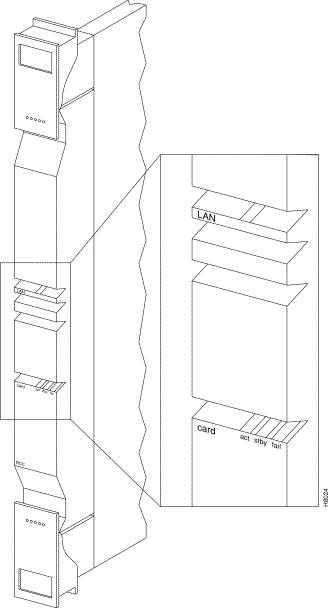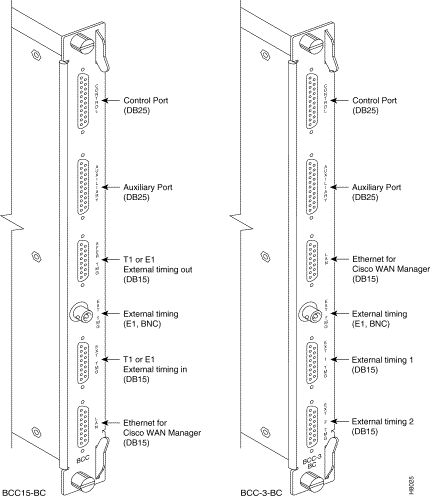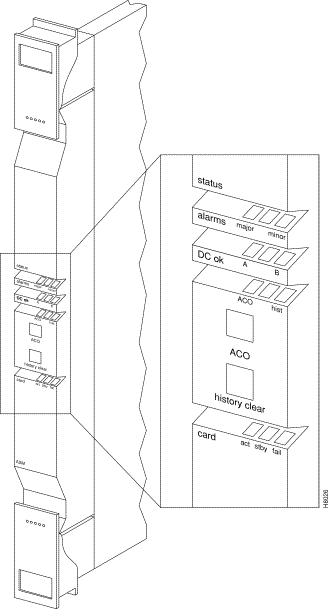|
|

This chapter contains a description of the common core group, comprising the Broadband Controller Cards (BCCs), the Alarm/Status Monitor (ASM), associated backcards, and StrataBus backplane.
This chapter contains the following:
The BPX switch Common Core group includes the following items shown in Figure 3-1:
The BCC-3-32M, BC-3-64M, and BCC-32 are functionally equivalent except for performance and support 9.6 Gbps operation, but use different backcards. The BCC-4V provides a new 16 x 32 crosspoint switch architecture to extend the BPX peak switching capability from 9.6 up to 19.2 Gbps peak. The BCC-4V also provides 4 MBytes of BRAM and 128 MBytes of DRAM.
The common core group functions include:
The Broadband Controller Card is a microprocessor-based system controller and is used to control the overall operation of the BPX switch. The controller card is a front card that is usually equipped as a redundant pair. Slots number 7 and number 8 are reserved for the primary and secondary (standby) broadband controller cards. Each broadband controller front card requires a corresponding back card.

The BCC-3-32M, BCC-3-64M, and BCC-32 are functionally equivalent except for performance. However, the BCC-4V provides a new 16 x 32 cross-point architecture that increases the peak switching capacity of the BPX switch to 19.2 Gbps, with a sustained non-blocking throughput of 9.6 Gbps. The term BCC is used in this manual to refer to the functional operation of the Broadband Controller Card. When a difference in operation does occur, the specific type of BCC is specified. This card group (see Figure 3-1) provides the following functions:
The Broadband Controller Card performs the following major system functions:
Each Broadband Controller Card includes the following:
The BPX switch is a space switch. It employs a crosspoint switch for individual data lines to and from each port. The switching fabric in each BPX switch consists of three elements for the BCCs (see Figure 3-2 and Figure 3-3):
Since there are 16 X 16 (BCC-32 or BCC-3-32M, or BCC-3-64M) or 16 X 32 (BCC-4V) independent crosspoints and only 15 cards, the switch fabric is non-blocking. However, only one connection at a time is allowed to an individual card. The BPX switch cell switching is not synchronized to any external clocks; it runs at its own rate. No switch fabric clocks are used to derive synchronization nor are these signals synchronized to any external sources.
With the BPX switch equipped with two BCCs, the cell switching is completely redundant in that there are always two arbiters, two crosspoint switches, two completely independent data buses, and two independent polling buses.
The BCC incorporates non-volatile flash EEPROM which permits new software releases to be downloaded over the network and battery-backup RAM (BRAM) for storing user system configuration data. These memory features maintain system software and configuration data even during power failures, eliminating the need to download software or reconfigure after the power returns.
Node clocking is generated by the BCC. Since the BPX switch resides as an element in a telecommunications network, it is capable of synchronizing to higher-stratum clocking devices in the network and providing synchronization to lower stratum devices. The BCC can be synchronized to any one of three different sources under software control:
The BCC clock circuits provide clocking signals to every other card slot. If a function card needs to synchronize its physical interface to the BPX switch clock, it can use this timing signal to derive the proper reference frequency. These reference frequencies include DS1, E1, DS3, and E3.


The BCC front panel has four Led, three card status LEDs, and a LAN LED. (See Figure 3-4 and Table 3-1.)
| No | Indicator | Function |
|---|---|---|
1 | LAN | Indicates there is data activity over the Ethernet LAN port. |
2 | card - act | Card active LED indicates this BCC is on-line and actively controlling the node. |
3 | card - stby | Card standby LED indicates this BCC is off-line but is ready to take over control of the node at a moments notice. |
4 | card - fail | Card fail LED indicates this BCC has failed the internal self-test routine and needs to be reset or replaced. |

The BCC runs self-tests continuously on internal functions in the background and if a failure is detected, the fail LED is lighted. If the BCC is configured as a redundant pair, the off-line BCC is indicated by the lighted stby LED. The stby LED also flashes when a software download or standby update is in progress. The LAN LED indicates activity on the Ethernet port.
In order to operate the BPX switch at up to a 19.2 Gbps peak throughput, the following is required:
The 19.2 backplane can be visually identified by the small white card slot fuses at the bottom rear of the backplane. These fuses are approximately 1/4 inch high and 1/8 inch wide. The 9.6 Gbps backplane does not have these fuses. If the BPX switch is a late model, then a 19.2 Gbps backplane is installed. This can be verified by running the despond command which will display "Word #2 =0001" if the backplane NOVRAM has been programmed. If anything else is displayed, visually check the backplane for the fuses.
If the backplane is a 19.2 Gbps backplane, but the backplane NOVRAM has not been set to display Word #2 =0001, then the cnfbpnv command may be used to program the NOVRAM as follows:
Are you sure this is a new backplane (y/n).
Step 2 Enter y
Step 3 Confirm that the change has been made by entering dspbpnv to confirm the response:
Word #2 =0001
Step 4 Enter switchcc in order for the change to be recognized by the switch software.
If the backplane is not a 19.2 Gbps backplane, then it will be necessary to install a 19.2 Gbps backplane to obtain 19.2 Gbps operation. Contact Customer Service.
The backcards for the Broadband Controller Card serve as an interface between the BPX switch and the BPX switch network management system. For the BCC-32, the backcard is the BCC15-BC. For the BCC-3-32M, BCC-3-64M, and BCC-4V, the backcard is the BCC-3-BC. (These backcards are also known as the BCC backcards). The BCC-3-32M, BCC-3-64M,and the BCC-32 are functionally interchangeable except for performance, while the BCC-4V provides additional important features such as support for up to 19.2 Mbps peak operation with BXM cards. Both BCCs in a node should be of the same type. The backcard provides the following interfaces:
The face plate connectors are described in Table 3-2 and Table 3-3 and shown in Figure 3-5. The BCC15-BC is shown on the left and the BCC-3-BCC is shown on the right of Appendix Figure 3-5. For information on cabling, refer to Appendix B, BPX Switch Cabling Summary.
| Connector | Function |
|---|---|
CONTROL | A DB25 connector for a VT100 or equivalent terminal for a basic terminal connection using command line interface commands. Can also be connected to a dial-in modem for remote service support or other network management dial-up access. This is a bidirectional RS232 communications port. This is not used for CWM Network Management; the LAN connector is used for CWM Network Management. |
AUXILIARY | A DB25 connector for a system printer. This is a one-way, RS232 outgoing port. |
XFER TMG | DB15 connector that supplies an 8-kHz timing signal (RS422 type output that is synchronized to the BPX switch system clock.) |
EXT TMG | A 75-ohm BNC connection for clock input. An E1 source with 75 ohm impedance typically uses this connector. If the shield on the cable needs grounding, slide the BCC back card out and jumped connector JP1 across its two pins. |
EXT TMG | DB15 connector for a primary and optional redundant external source of system clock. A T1 source with 100 ohm impedance or an E1 source with 100/120 ohm impedance typically use this connector. |
LAN | A DB15 Ethernet LAN connection for connecting to a CWM NMS. A terminal or NMS other than CWM can also be connected to the BPX switch LAN port via Ethernet. However, only the CWM NMS provides full management configuration and statistics capabilities via SNMP and TFTP. |
| Connector | Function |
|---|---|
CONTROL | A DB25 connector for a VT100 or equivalent terminal for a basic terminal connection using command line interface commands. Can also be connected to a dial-in modem for remote service support or other network management dial-up access. This is a bidirectional RS232 communications port. This is not used for CWM Network Management; the LAN connector is used for CWM Network Management. |
AUXILIARY | A DB25 connector for a system printer. This is a one-way, RS232 outgoing port. |
LAN | A DB15 Ethernet LAN connection for connecting to a CWM NMS. A terminal or NMS other than CWM can also be connected to the BPX switch LAN port via Ethernet. However, only the CWM NMS provides full management configuration and statistics capabilities via SNMP and TFTP. |
EXT TMG | A 75-ohm BNC connection for clock input. An E1 source with 75 ohm impedance typically uses this connector. If the shield on the cable needs grounding, slide the BCC back card out and jumper connector JP1 across its two pins. |
EXT 1 TMG | DB15 connector for a primary and optional redundant external source of system clock. A T1 source with 100 ohm impedance or an E1 source with 100/120 ohm impedance typically use this connector. |
EXT 2 TMG | Provides for an external clock source redundant to the EXT 1 TMG source. |

Another function of the line module back card is to provide two low-speed, serial communications ports. (Refer to Table 3-3.) The first port (CONTROL) is a bidirectional port used for connecting the BPX switch to a local terminal or to a modem for a remote terminal "dial-in" connection. The second port (AUXILIARY) is an output only and is typically used to connect to a log printer.
The CWM NMS is connected to the LAN port on the BCC backcards. When control is provided via an Ethernet interface, the node IP address is configured with the cnflan command for the BPX switch, and the for redundancy the LAN ports on both BCC back cards each connected to an AUI adapter. The LAN port of the primary Broadband Control Card is active. If the secondary Broadband Control Card becomes primary (active), then its LAN port becomes active. The CWM workstation will automatically try to restore communications over the LAN and will interface with the newly active Broadband Controller Card.
For small networks, one CWM workstation is adequate to collect statistics and provide network management. For larger networks additional CWM workstations may be required. Refer to the Cisco WAN Manager Operations Guide for more information.
The ASM card provides a number of support functions for the BPX switch including:
There are four significant circuits controlled by the ASM processor: alarm, power supply monitor, fan and temperature monitor, and card detection. The alarm monitor controls the operation of the front panel alarm LEDs and ACO and history pushbuttons as well as the alarm relays which provide dry contact closures for alarm outputs to customer connections. BPX switch system software commands the ASM card to activate the major and minor alarm indicators and relays.
The power supply monitor circuit monitors the status of the -48V input to the shelf on each of the two power buses, A and B. The status of both the A bus and B power bus is displayed on the ASM front panel.
The front panel displays the status of the node and any major or minor alarms that may be present. Figure 3-6 illustrates the front panel of the ASM card. Each front panel feature is described in
Table 3-4.
| No | Controls/ Indicator | Function |
|---|---|---|
1 | alarms LEDs | A red major alarm and a yellow minor alarm indicator to display the status of the local node. In general, a major alarm is service-affecting whereas a minor alarm is a non-service affecting failure. |
2 | dc LEDs | Two green LEDs displaying the status of the two dc power busses on the Stratabus backplane. On-indicates voltage within tolerance. Off-indicates an out-of-tolerance voltage. |
3 | ACO/hist LEDs | ACO LED (yellow) lights when the front panel ACO pushbutton is operated. History LED (green) indicates an alarm has been detected by the ASM at some time in the past but may or may not be clear at present time. |
4 | ACO switch | When operated, releases the audible alarm relay. |
5 | history clear switch | Extinguishes the history LED if the alarm condition has cleared. If the alarm is still present when the history clear switch is thrown, the history LED will stay lit. |
6 | card status LEDs | Active (green) indicates card is on-line and clear of alarms. Standby (yellow) indicates card is off-line. Fault (red) indicates a card failure is detected by the card self-test diagnostics. |

Figure 3-7 illustrates the face plate of the LM-ASM which contains a single subminiature connector (see Table 3-5). The Alarm Relay connector provides dry-closure (no voltage) relay contact outputs.
| No | Connector/ Indicator | Function |
|---|---|---|
1 | ALARM RELAYS | A DB15 connector for alarm relay outputs. Refer to Chapter 3 or Appendix C for pinouts. |

The BPX switch may be equipped with a backplane that supports either a 9.6 or up to 19.2 Gbps operation. The 19.2 Gbps backplane can physically be identified by the card slot fuses on the bottom rear of the backplane. All BPX switch modules are interconnected by the BPX switch StrataBus backplane physically located between the front card slots and the back card slots. Even though the ATM data paths to/from the switching fabric and the interface modules are individual data connections, there are also a number of system bus paths used for controlling the operation of the BPX switch. The StrataBus backplane, in addition to the 15 card connectors, contains the following signal paths:
All StrataBus wiring is completely duplicated and the two sets of bus wiring operate independently to provide complete redundancy. Either the A side wiring or B side wiring is enabled at any particular time by signals on the Control bus.
![]()
![]()
![]()
![]()
![]()
![]()
![]()
![]()
Posted: Sun Jan 14 18:39:47 PST 2001
All contents are Copyright © 1992--2001 Cisco Systems, Inc. All rights reserved.
Important Notices and Privacy Statement.